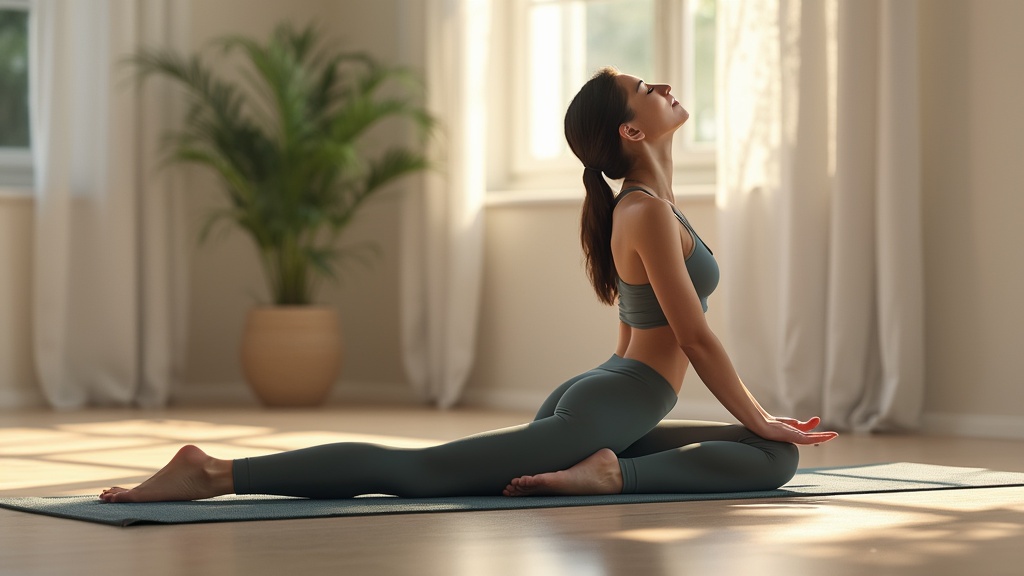
Lower back tightness affects many individuals, significantly impacting daily activities. Effective stretches can promote muscle tension relief and enhance overall flexibility, reducing discomfort associated with lower back pain.
Incorporating these stretches into your routine can lead to improved range of motion and prevent future injuries.
For optimal results, focus on exercises like the catcow stretch and seated spinal twist, which target key muscle groups.
Regular practice of these stretches contributes to better lumbar support and aids in pain management. Always ensure you warm up before engaging in any physical activity to avoid strain.
Understanding Lower Back Pain
Discomfort experienced in the lumbar region often manifests as persistent aching or stiffness.
Common causes of lower back pain include muscle or ligament strain, herniated discs, and conditions like arthritis. Lifestyle factors significantly contribute; for example, a sedentary lifestyle can exacerbate tightness.
Poor posture while sitting or standing can lead to increased pressure on the lower back.
If you experience severe pain, particularly when it affects your daily activities or persists for weeks, seeking professional help is essential.
Timely intervention can provide crucial spinal alignment and enhance your overall physical wellness.

Effective Flexibility Exercises For Relief
Integrating flexibility exercises into your daily routine can significantly alleviate lower back pain. Key stretches, such as the Child’s Pose, which elongates the spine, and the Cat-Cow Stretch, enhancing spinal mobility, prove effective for relief.
The Seated Forward Bend targets hamstrings and promotes lower back comfort.
To seamlessly incorporate these movements, consider performing them in the morning or during work breaks.
Warming up for at least 5-10 minutes is essential; light cardio, such as walking, prevents injuries while optimizing the effectiveness of these vital flexibility exercises.
Key Flexibility Exercises
- Child’s Pose: This stretch elongates the spine and promotes relaxation.
- Cat-Cow Stretch: This dynamic movement enhances spinal mobility and promotes lumbar support.
- Seated Forward Bend: This exercise targets hamstrings, enhancing lower back mobility.
- Standing Forward Bend: This stretch increases flexibility and encourages better posture.
- Seated Spinal Twist: This stretch improves spinal alignment and fosters body awareness.
How To Use Muscle Tension Relief Techniques
Employing muscle tension relief techniques is essential for enhancing back health. Simple methods, such as deep breathing, effectively reduce stress while facilitating muscle relaxation. Progressive muscle relaxation systematically tenses and relaxes muscle groups, promoting overall tension release. To implement these techniques, consider a daily routine that includes stretching, deep breathing, and foam rolling.
Daily Routine Example
Setting aside 15 minutes each day can build consistency and reinforce your commitment to your wellness routine. Here is a practical way to organize your routine:
- Start with breathing exercises to calm the mind and body.
- Follow with dynamic stretching, including the Cat-Cow Stretch.
- Incorporate foam rolling on tight muscle groups for tension alleviation.
- Finish with gentle yoga poses such as the Child’s Pose.
By regularly addressing muscle tension, individuals may experience enhanced mobility and a reduction in lower back pain, contributing to a holistic wellness strategy.
Flexibility and Muscle Tension Relief
- Regular flexibility exercises can reduce the risk of lower back pain by improving spinal mobility.
- Deep breathing techniques have been shown to lower stress levels, which can contribute to muscle tension relief.
- Progressive muscle relaxation can enhance overall physical well-being by systematically reducing tension throughout the body.
- Incorporating a consistent routine of stretching and relaxation techniques can lead to improved overall wellness and mobility.
Importance Of Lumbar Support In Stretches
Proper lumbar support significantly enhances the effectiveness of stretching by maintaining spinal alignment during flexibility exercises. Utilizing lumbar support tools, such as lumbar rolls or supportive cushions, helps ensure that the natural curve of the spine is preserved.
This preservation aids in posture improvement, minimizing the risk of injuries that often arise from improper technique.
By maintaining a neutral spine while stretching, individuals can deepen their stretches and experience greater muscle tension relief.
Thus, emphasizing lumbar support not only enhances flexibility but also contributes to a more effective and comfortable stretching routine.
Core Stability And Its Role In Back Health
Establishing core stability plays an essential role in preventing lower back pain, as a strong core effectively supports spinal alignment. Exercises such as planks, bridges, and hamstring stretches bolster core strength while relieving stress on lower back muscles, which subsequently promotes better posture.
Research indicates that improved core strength correlates with a decrease in incidents of back pain, positioning these exercises as fundamental components of physical wellness. To seamlessly integrate core workouts into regular fitness routines, consider allocating brief sessions dedicated to core stability training, thereby enhancing overall strength and offering resilience against potential injuries.
| Benefit | Details |
|---|---|
| Enhanced Flexibility | Maintaining spinal alignment during stretching leads to deeper stretches. |
| Injury Prevention | Proper lumbar support minimizes injury risks associated with improper technique. |
| Improved Posture | Utilizing lumbar support tools helps preserve the natural curve of the spine. |
| Core Strength Correlation | Increased core stability is linked to a reduction in lower back pain incidents. |
Can Yoga For Back Help Tightness
Incorporating yoga into a regular wellness routine can effectively alleviate lower back pain. Specific yoga poses, such as Child’s Pose and Cat-Cow Stretch, are beneficial for promoting flexibility and mobility in the back.
These poses enhance spinal alignment, contributing to muscle tension relief and restoring balance.
For maximum benefit, practicing yoga for just 15 minutes, three times a week can significantly improve back flexibility.
Consider scheduling sessions in the morning to prepare your body for a day of activities. Integrating these yoga movements into your schedule may facilitate improved core stability and overall comfort.
Exploring Deep Stretches For Pain Management
Deep stretches are integral to managing pain management effectively.
Engaging in stretches like the Seated Forward Bend and Figure Four Stretch specifically target key areas, alleviating discomfort and enhancing overall flexibility. A suggested routine for maximizing the benefits includes:
- Warm-ups: Start with gentle mobility drills to prepare your body.
- Deep stretches: Incorporate stretches such as the Cat-Cow Stretch and Standing Forward Bend.
- Restorative poses: Conclude with a restorative pose like Savasana to encourage muscle relaxation.
This combination encourages effective tension release and promotes muscle relaxation. Incorporating breathing exercises throughout the session further enhances mental wellness and bodily awareness. A holistic approach to back health can effectively alleviate pain and support overall well-being.
Yoga and Back Health
- Studies show that regular yoga practice can reduce lower back pain by up to 50%.
- Yoga poses improve spinal alignment and flexibility, which are essential for back health.
- Incorporating breathing exercises into yoga sessions enhances relaxation and reduces stress, contributing to pain relief.
- Practicing yoga for just 15 minutes, three times a week, can lead to significant improvements in core stability and overall comfort.
Benefits Of Daily Stretching For Mobility
Incorporating daily stretching into your routine offers substantial advantages for enhancing mobility. Daily stretching exercises significantly improve flexibility, which benefits various physical activities and enhances overall performance.
Over time, this practice leads to a greater range of motion, reducing the risk of injury during workouts.
Consistent stretching enhances circulation, which promotes muscle relaxation and quicker recovery following intense physical activities.
- Improved posture contributes to lower back pain relief and overall back health.
- Daily stretching routines are essential for effective pain management and tension alleviation.
- Incorporating yoga poses for back tightness can facilitate a more consistent stretching habit.
Creating a Consistent Daily Stretching Routine
To establish an effective daily stretching routine, consider setting aside specific times, such as after workouts or during morning routines. Routine stretching should include practical stretches like the cat-cow stretch and standing forward bend, which enhance lumbar support and overall mobility. Integrating stretches that focus on hamstring stretches and hip flexor relief can further improve your physical wellness and body mechanics. For best results, perform these stretches slowly, allowing your body adequate time to adapt.
Practicing breathing exercises during stretching sessions can contribute to mental clarity and body awareness, enhancing the overall experience. Remember that consistency in this self-care routine yields long-term benefits, including improved spinal alignment and enhanced lower back mobility.
- Regular stretching can increase flexibility by up to 30%, enhancing performance in physical activities.
- Studies show that daily stretching can reduce the risk of injury by improving the range of motion.
- Incorporating stretching into your routine can lead to a significant decrease in muscle soreness and recovery time.
- Practicing stretching and breathing exercises together can improve mental clarity and body awareness, promoting overall wellness.
